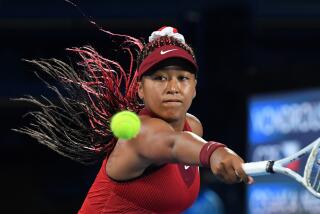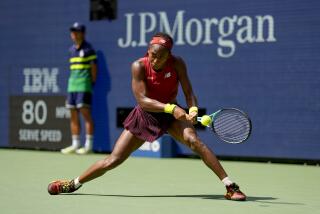BIG RETURN
- Share via
INDIAN WELLS, Calif. — Why is it that you have to disappear to become truly and fully appreciated?
After 103 tournament titles, including 21 Grand Slam singles championships, and a decade and a half of producing laser-like forehands, Steffi Graf is now realizing how the public and players feel about her legacy and, for that matter, her future.
All it took was career-threatening knee surgery.
“Anywhere I’ve been, people react,” Graf says. “I’m surprised. I do feel that because people are still interested in seeing me play. I wouldn’t get that recognition if I hadn’t been around a long time.
“It must be funny for Chris [Evert] and Martina [Navratilova] to still be playing the seinor tournaments--it must be nice to see how people appreciate them.”
One circuit and one state away, the same thing is happening with Andre Agassi.
Agassi, Graf’s comeback cousin, is accepting the kudos and compliments after his return to form, following a sizable drop off tennis’ radar screen. The other day in Scottsdale, Ariz., he was talking about another top female tennis player when his face suddenly brightened.
“I’m pulling for Steffi,” he said. “We’re both ranked 49th this week.”
Not exactly, but close enough.
Agassi probably understands better than anyone what it means to be dismissed as yesterday’s news and then embraced like a down-on-his-luck star who has just been nominated for an Oscar.
Graf, ranked 45th, did not watch much tennis during her eight-month absence from the Corel WTA tour, but she was aware and sensitive to the slights and barbs thrown Agassi’s way when he played the Challenger circuit.
“I was so upset when they were writing, ‘How low did he get?’ ” she said. “You need to start somewhere. I think that was a very good decision.
“We’re all out there, doing it maybe for a little bit for other people too. But fortunately, we do it because we want to do it. He’s proving it to them, and that’s the only way you can respond to it. So I’m happy for him.”
Graf’s comeback road is different, of course, because of the seriousness of the injury to her left knee. The June surgery--for torn cartilage and a partial rupture of the patellar tendon--followed her quarterfinal loss at the French Open to Amanda Coetzer.
Her appearance here at the State Farm Evert Cup is the second tournament of the comeback, and she will play Tamarine Tanasugarn of Thailand today in the second round.
Last month, Graf returned to the circuit in her native Germany, at Hanover, winning her first match against countrywoman Andrea Glass before falling in the next round to Sabine Appelmans of Belgium, a solid pro who has been in the top 20.
Naturally, Graf’s reappearance in Germany was a seismic event. Her match against Glass easily produced better ratings than the Winter Olympics, proving Germans also like watching events held the same day.
For Graf, home adoration and high expectations cut both ways.
“In terms of the reception I got--and how special it felt to be back on the court--absolutely, I don’t think I expected it,” she said. “That’s why it was very emotional for me. It caught me off the wrong foot.
“In other terms, I felt a lot of pressure starting in Germany. It was difficult in the weeks before, they [the media] wrote a lot of things.”
Graf had been close to returning twice before. She was set to leave for an event in Tokyo and suffered a minor setback the day before her departure. The delay also meant she wasn’t able to practice enough before her next scheduled tournament in Paris, and Graf pulled out there. So when Hanover rolled around, Graf almost felt as if she had to play after the two near-misses.
“There was a little bit I felt I needed to show, that I’m not pulling any stunts, I’m not trying to fool anybody,” she said.
Against Appelmans, the knee wasn’t the problem, but nerves were.
“I was a little tight,” Graf said. “And then the [calf] muscle got tight. That match I didn’t move very much. I’m not afraid of moving now.”
The lack of match play means a journey into the unknown. Five months of rehabilitation in Austria to build up the knee and practice sessions aren’t matches against Martina Hingis or Lindsay Davenport. Graf acknowledges her confidence level is “lacking basically.”
At the moment, she can’t seem to get any assistance from her body, still fighting off a 10-day-old cold.
Graf, 28, is self-deprecating when asked how she is doing.
“I’m feeling great,” she said, laughing between sneezes and sniffles.
Though she has played her way and won Grand Slam events through many a cold, this is a different fight, one against the knee that produced so much pain that Graf could not walk up a flight of stairs at the 1997 French Open.
Certainly, the seeds of doubt were planted, and one of the best tennis players in history thought it may be over.
“Oh, yeah, many times,” Graf said. “First of all, I wasn’t sure if the operation--they can’t tell you if it’s going to work afterward. It was not an easy operation. I’ve had one year of problems before. It wasn’t like an injury that happened and you quickly resolve it.”
Graf, one of the best athletes and fastest players on the tour, had other questions.
“My first concern was to be able to walk without pain,” she said. “I wasn’t able to do that anymore without major pain.
“I’ve always lived with sports and to not be able to do anything--I couldn’t even do stairs--would have been difficult for me.
“Once I realized everything was fine and I would be able to work out and do anything, that was the big step. Then it was to try and play tennis.”
Blessed with a fierce determination, Graf was probably harder on herself than anyone else on tour on her way to seven Wimbledon titles, a Grand Slam in 1988 and and the No. 1 ranking for a record total of 374 weeks.
Now she is forced to be patient, a difficult tightrope between pushing herself too hard and not pressing enough.
“I never realized it was going to be that difficult,” she said. “But you start to move differently [with an injury]. You start to walk differently. I was jogging and people were saying, ‘You’re still limping.’ I said, ‘What are you talking about?’
“I felt I was walking normal, but I was still limping. These things are difficult to get out of the system.”
Asked if it was difficult to realize she may have to lose before she wins, Graf said: “I haven’t thought about that very much because I just knew that was going to happen. There was nothing that I was afraid of. Do I get my rhythm back? Am I going to be able to be running around the way I was before? These questions do arise. But it’s going to take a few more weeks. I need to find some continuity.”
Now that search continues at Indian Wells, an event she won in 1994 and 1996. Oddly enough, Southern California has been the barometer of several key moments in Graf’s career. In 1984, the shy 15-year-old with a huge forehand won a gold medal in the Olympics at the UCLA courts when tennis was a demonstration sport.
Three years later, she became No. 1 in the world at Manhattan Beach, completing her rise with a victory over Chris Evert and celebrating with a carefree, giddy walk on the beach with her father, Peter.
So much has happened to Graf in her time away from the circuit--the ups and downs and uncertainty--she finds it amusing to return to the tour and find the outward trappings virtually untouched, with maybe a few new faces.
“It’s like nothing has changed,” she said, laughing. “It’s always the same people. . . . It’s scary.”
Not quite like the movie “Groundhog Day” but close enough.
(BEGIN TEXT OF INFOBOX / INFOGRAPHIC)
Drop Shot
Because of injuries, Steffi Graf has won only one tournament since Nov. 1996. A look at her year-end ranking on the WTA tour. She currently is ranked 45th.
*--*
Year Rank 1982 214 1983 98 1984 22 1985 6 1986 3 1987 1 1988 1 1989 1 1990 1 1991 2 1992 2 1993 1 1994 1 1995 1 1996 1 1997 28
*--*
More to Read
Go beyond the scoreboard
Get the latest on L.A.'s teams in the daily Sports Report newsletter.
You may occasionally receive promotional content from the Los Angeles Times.











